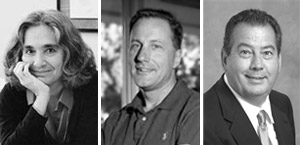

Friday - September 4, 2009
SLAC Today is
available online at:
http://today.slac.stanford.edu
In this issue:
From Persis, Paul and Bill: Two Years!
Large Area Telescope Collaboration Meeting Wraps Up Today
New Highway Signs for SLAC
Around SLAC: The BaBar Detector Core
 |
 |
|
Friday - September 4, 2009 |
From Persis, Paul and Bill: Two Years! Anniversaries are important to help us reflect on where we were and see where we are going. It has been two years since Paul Golan became head of the SLAC Site Office and two years since Persis Drell stepped in as acting director. Bill Madia joined officially as Stanford vice president for SLAC in January, 2008, but two years ago he was already heavily involved in advising lab management through the Scientific Policy Committee. The three of us thought this was a good occasion to pause and reflect. Trust and teamwork: So much of our progress in the past two years has come about because the three of us have built strong relationships based on trust. Early in 2008, we developed, signed and distributed a "partnership commitment" statement that has formed the basis of our working relationship. Simply put, as representatives of the lab, the Site Office and the university, we work together in full partnership and we work collaboratively to solve problems. Read more... Large Area Telescope Collaboration Meeting Wraps Up TodayToday, members of the Fermi Gamma-ray Space Telescope's Large Area Telescope collaboration are wrapping up a week considering the prodigious amount of data collected over the instrument's first year of science and charting a course for future analyses. The LAT collaboration meeting, which started last Saturday, brought 180 students and scientists from around the world together at SLAC. Participants attended collaboration-wide presentations in the morning, breaking into smaller groups in the afternoon. "It's important to get everyone together once in a while to trade ideas across the collaboration and to plan the next round of analysis," Michelson said. "That's the idea, to get people together to talk." This year's meeting falls just after a key transition for the Fermi telescope. By an agreement between the collaboration and NASA, high level data collected by the LAT, along with the data analysis tools used, are now being made available to the public. "We've moved into a brave new world of how the collaboration conducts science," said Kavli Institute scientist and LAT Instrument Science Operations Center Manager Rob Cameron. New Highway Signs for SLACSLAC visitors will have an easier time finding the lab thanks to six new freeway signs on Interstate 280. Starting about a quarter mile from the preceding exit in each direction are three green signs that read "SLAC National Accelerator Laboratory," reflecting the lab's name change of just under one year ago. "This was hard to do," said SLAC employee Al Baker who worked to get these as well as the original set of highway signs in 2000. The first time around, the government installed the signs free of cost, but because this was simply a name change, SLAC had more to do this time. "First you have to find a contractor to do it," Baker said. He found John McGuire Construction in Auburn, California. After finding a contractor, it took time to determine a procedure at SLAC for ordering and installing new freeway signs. "Eventually we got it all done and we are very happy with it," Baker said. "We hope these signs will be up there many more years." Around SLAC: The BaBar Detector CoreAfter an hour of meticulous preparation, the core of the BaBar detector was opened last Friday morning, revealing the cylindrical vacuum chamber where collisions between electrons and anti-electrons, or positrons, occurred. Surrounding the chamber like flower petals were five layers of iridescent silicon chips. Several hundred of these delicate chips detected the millions of B mesons produced by the PEP-II storage ring over nearly a decade of operation. Steve Dardin, Rod Post and Roy Kerth of Lawrence Berkeley National Laboratory
performed the delicate work of opening the detector
core. (Photo by Brad Plummer.)
The two halves of the detector are being carefully prepped for public display. One half will travel to the Italian National Institute of Nuclear Physics, INFN. The other will remain in the U.S. The fifteen-year-old design could help guide future detectors built with updated components. "You would want to do it with modern chips," said SLAC physicist Mike Sullivan, who helped design the interaction region for the BaBar experiment. INFN hopes to build a new electron-positron collider, named SuperB. Sullivan has helped design the collision point of the Italian proposal, which will include new innovations in technical design. "The particles will collide at an angle instead of head-on as we had in PEP-II," he said. The new collision scheme could generate as much as 100 times the highest luminosity seen in the PEP-II B Factory. |
Events
Access (see all)
Announcements
|
|
| | ||
|
|
||
 <%
Response.AddHeader "Last-modified", getArticleDate()
'Response.AddHeader "Last-modified","Mon, 01 Sep 1997 01:03:33 GMT"
'Monday, December 06, 2010
%>
<%
Response.AddHeader "Last-modified", getArticleDate()
'Response.AddHeader "Last-modified","Mon, 01 Sep 1997 01:03:33 GMT"
'Monday, December 06, 2010
%>View online at http://today.slac.stanford.edu/. |
||